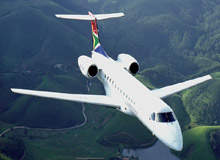The ERJ-135 is a 3,148km range, 37-passenger airliner and a member of the Embraer regional jet series. The launch of the aircraft was in 1997 and the first flight was carried out in July 1998. Certification from the Brazilian Centro Tecnico Aerospacial (CTA), the US Federal Aviation Administration (FAA) and the European Joint Aviation Authorities (JAA) was awarded in 1999.
The aircraft entered into service with Continental Express and American Eagle in July 1999. Approximately 132 ERJ-135 regional jets have been ordered for operators including British Midland, Chautauqua Airlines, City Airlines, Flandre Air, Jetmagic, Luxair, Proteus and South African Air Link.
A production facility for the ERJ-135 / 140 / 145 aircraft has been set up in Harbin, China, in a joint venture with Harbin Aircraft.
In November 2007, a contract was placed for two aircraft for the Royal Thai Army and two for the Royal Thai Navy. The aircraft will be used for transport and medical evaluation missions.
In October 2009, two ERJ-135 and one ERJ-145 regional jets were delivered to Servicos Executivos Aereos de Angola (SEAA), an African-based start-up scheduled airline. The ERJ-135 jets were initially used on domestic routes including Luanda, Cabinda, Ondjiva and Saurimo.
In January 2010, ECC Leasing, a subsidiary of Embraer, leased four ERJ-135 jets to South African AirLink.
The aircraft will be based in Johannesburg, South Africa and will be deployed on regional routes.
ERJ-135 design
The aircraft shares 98% parts and systems commonality, as well as crew rating, with the other members of the ERJ-135 / 140 / 145 family.
Final assembly, systems integration and testing are carried out at Embraer’s aerospace manufacturing facilities in Sao Paulo. Manufacture of some sections of the aircraft is carried out by subcontractors and the subassemblies are transported to Sao Paulo for assembly. Norton supplies the nose radome, Sonaca of Belgium the rear and centre section of the fuselage, Gamesa of Spain the wings and ENAER of Chile the fin and tailplane.
The aircraft has a circular cross section fuselage, rear mounted high by-pass ratio engines, low mounted swept wings and a T-tailplane. The wings are of two spar wing design with a third spar to support the landing gear. The wing leading edges are made of aluminium.
The wings of the extra-long-range ERJ-145XR are fitted with winglets that increase lift and improve the efficiency of the wing at cruise speed by reducing the drag of the tip vortex. The T-tail is of aluminium box construction with aluminium leading edges on the tailplane. The fin leading edge is of composite construction.
Flight deck
The cockpit is fitted with an all-glass Honeywell Primus 1000 digital avionics suite with dual digital air data computers, dual attitude, heading and reference system (AHRS), a traffic alert and collision avoidance system (TCAS) and a ground proximity warning system (GPWS).
The instrumentation includes a Flight Dynamics head-up display that gives the aircraft CAT III landing capability. Five electronic flight and information system displays, each measuring 20.3cm×18cm (8in×7in), include two multifunction displays, two primary flight displays and one in-flight engine condition monitoring system (IECMS).
An optional flight management system and global positioning system can be fitted. The aircraft has a Primus 1000 colour weather radar and a dual Primus II radio communications suite.
Cabin
The main cabin, designed by the aircraft interior design company, C&D Interiors of the US, provides three-abreast seating for up to 37 passengers. The interior of the aircraft can easily be configured in a different arrangement to suit customers’ specific requirements.
There is an airstairs passenger door at the front port side of the cabin. The cabin and baggage compartments are air-conditioned and pressurised by a Hamilton Sundstrand air-conditioning system and Liebherr Aerospace pressurisation system. The oxygen system is supplied by EROS.
ERJ-135 engines
The aircraft has two rear-mounted Rolls-Royce engines mounted on pylons, supplied by Sonaca of Belgium. International Nacelle Systems supplies the engine nacelles and the optional clamshell thrust reversers. The engines are fitted with full authority digital engine control and the engine air intakes are fitted with an engine bleed air anti-icing system.
The ERJ-135ER aircraft has Rolls-Royce AE 3007A engines rated at 31.3kN and the long range ERJ-135LR aircraft is equipped with Rolls-Royce AE 3007A1 engines, which provide 15% more power. The engines are flat rated at 33.1kN to provide improved climb characteristics and improved cruise performance in high ambient temperatures.
The aircraft is equipped with a Parker Hannifin fuel management system. The integral wing tanks have a capacity of 4,173kg of fuel in the ERJ-135ER and 5,187kg in the ERJ-135LR. The aircraft is equipped with a Smiths electrical power system and a tail-mounted APIC APS-500 auxiliary power unit providing 18.6kW.
Landing gear
The aircraft is fitted with EDE retractable tricycle-type landing gear. Liebher produced the forward retracting nose landing gear. The main units retract inward into the wing and fuselage landing gear fairings. The units are fitted with Goodrich wheels and carbon brakes with a Hydro-Aire brake-by-wire control system.
Performance
The ERJ-135 can fly at a maximum speed of 955km/h. Its cruise speed is 833km/h. The range and service ceiling of the aircraft are 3,200m and 11,278m respectively. The take-off run of the aircraft is 1,700m while its landing run is 1,360m. The aircraft weighs approximately 11,200kg and its maximum take-off weight is 19,000kg.











